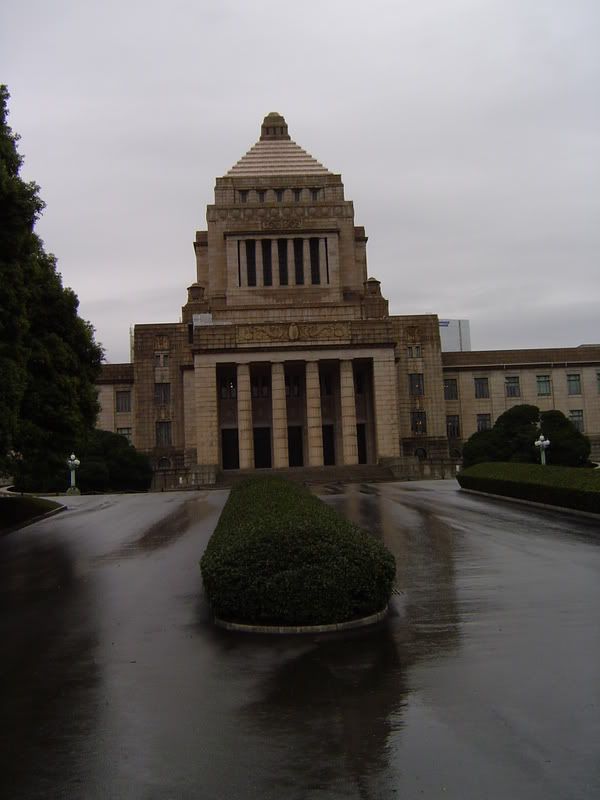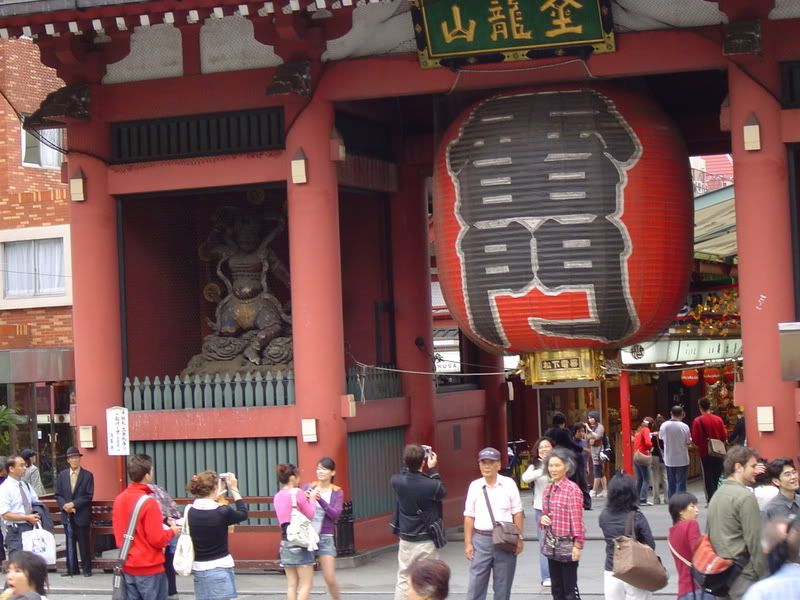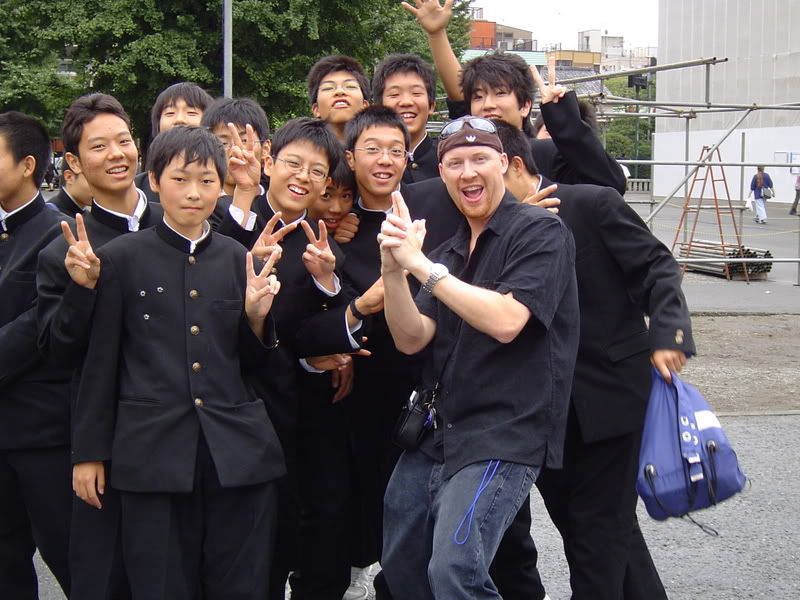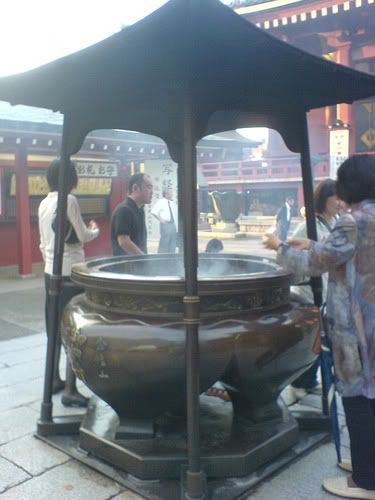10-05-06 Thursday "The Big Rush"
THURSDAY The Big Rush OCT 5th
We started again with a nice breakfast. I talked to a guy that some of us are now calling Indiana Dan, because he wears a pretty nifty Raiders Of The Lost Arc-like hat. Though he might look like a killer from an outback, he was really cool. He talked a bit to the others at the table about his job of trying to work meaning into students’ life where you actually apply critical thinking skills to workplace settings. It is always nice to chat with some educators. I love ripping off ideas. He inturn enjoyed hearing about our integrated English program within our CTE (trade) classes.
Next we went on a bus tour around Tokyo. The sheer enormity of Tokyo is staggering. About 12 million people (10 percent of Japan's population) live in Tokyo, but you don’t see the ridiculous traffic problems like you do in say a NYC. While Tokyo's subway and commuter railway network are the busiest in the world, it is relatively easy to get around.
Tokyo was designed around the turn of the century to be “rail-centric.” Construction was actually centered around major train stations in a high density fashion so large amounts of people would be able to get where ever they wanted fast and inexpensively. I learned from the tour that this differs from other world cities such as LA that were designed at a low density of human traffic and was laid out to be automobile friendly. By making mobility so much easier, one would gather that more businesses moved to Tokyo, which made a demand for more people to live here and subsequently increased population.

One of the first cool things that we saw was The Imperial Palace of Tokyo, but we only really rode past it. Our first real destination was “The Japanese Diet Building.” With a name like that, you would think that this place was a huge building filled with fish and Saki, but that was not the case. The Japanese Diet is similar to our House of Representatives. It has 480 members each term (since 1996), who are all elected on the same day for a stay of four year terms. The building was elephantine and we walked through with a tour of school students.
Outside the building was also a beautiful garden representing much of Japan’s most beautiful types of trees and plant life.

Our next destination was a stop to the Asakusa Temple & Shrine. At the Akasakusa Shrine, there is a famous fortune box, where people take fortunes out of little drawers. I went through the ritual and it told me I got fortune number 37 I believe, entitled appropriately for me “The Best Fortune.” However, a woman that I was walking with from our group named Victoria, a TV Production teacher from Miami, pulled “The Bad Fortune.” We learned however, that if you receive a bad fortune, all that you needed to do was tie it on a rack of strings, and the gods would make it go away. (Victoria was as quick as a cheetah to tie hers off so her house would not be destroyed.)

Aside from a number of tourists and other visitors, the most interesting thing about this is temple yard was the water purification statue and the Asakusa smoke pit.



The water purification statue was also a fountain where people would take water from little brass cups on poles and purify body and soul before entering the temple. The way one would do this is to touch each one of their wrists to cleanse their body, then rinse their mouths out and spit away the evil to cleanse their minds.
On the way to our lunch, we walked down a series of vendors selling candy, clothing, toys and other souvenirs. At the end of the strip was our lunch, a traditional Japanese restaurant located right in front of the Asakusa Shopping center. We waited in line and walked up a staircase. At the top we removed our shoes and put them into little baggies to retrieve later. Lunch was a very delicious Tempura assortment with lightly battered jumbo shrimp, peppers and something that reminded me of a Chinese dish like an egg foo young, but not as moist and more vegetable oriented. It was very relaxing to sit at the eastern setting before me, on the floor and take in such an alien but appealing site.
We returned to our hotel and were treated with four hours of speakers. As I was entering the hall, a JMF staffer told me that I could not enter, due to my JEANS! Eventually I was able to persuade them, however, I was told that I was NOT to stand at any cost during the speeches. Stupid gii-jin. (Dumb American.) Takahiro Miyao (pronounced “meow” like a kitty says) first gave us an exciting speech on the economic statud of Japan. In the hour and a half in which hhe spoke, I learned that Japan has lost a considerable amount of money in the market place over the last 15 years due to a High Budget deficit, a HUGE Social Security Burden (due to the elderly living so long) and a lack of innovation. It seems that Japan, while it does a super job manufacturing technology, is not very good in innovation; creating new products, rather than making old ones better.
After Yuji Yshima (Diet member), Hiroya Ichikaw (Professor of Sophia University and Kuniko Inoguchi (Cabinet Minister) spoke with us for a few more hours, I was ready to crash.
The last speaker was actually pretty cool and made us feel like we were in Oprah’s audience. She presented to us samples of Kenji Miyazawa’s works; an author of Japanese literature.
So by the time I got back to the room and was just about ready to crash, I was scooped up by Latina shopping guru Virginia of Miami. I wasn’t all that interested in shopping, however, I NEEDED PANTS. So a group of us went out in the pouring rain to check out The Asian Exchange and an upscale American thrift shop called CHICAGO. Most of the people in the group were hoping to buy stuff that looked like it came from Japan, because almost EVERYTHING for sale in Tokyo seemed to have English text on it all. (You would not believe how many people sell NY Yankees stuff.)The Asian Exchange was closed and just like Tokyo, there were no pants that fit me in CHICAGO.
The shopping spree was not a total failure, however. I made it to a 100 Yen store. These types of shops are much like our own “dollar stores”, but with better stuff because it is manufactured locally or nearby. I picked up about thirty pieces!
So at about 9:30, after a long day, I was starving so I suggested eating at a Japanese McDonald’s. And guess what I got? The Filet-o-Shrimp!!! (It was actually pretty good, topped with some kind of sweet dark brown sauce and something that wasn’t lettuce.)
Sianora. Train back to The New Otani.


0 Comments:
Post a Comment
<< Home